D(Delay) type flip-flop is the flip-flop to output the input state of the D terminal for output (Q) when clock (CK) changes into H from the L.
An equivalent circuit is composed by three SR (the set and the reset) FFs.
The equivalent circuit of D-FF
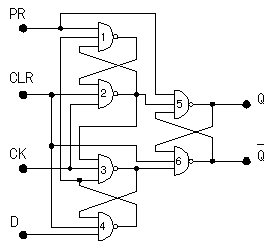
In the following explanation, figure from 1 to 6 shows NAND gate 1 to NAND gate 6 respectively.
SR-FF to compose by 1 and 2 is the FF to hold the condition when the D terminal changes into H from L.
SR-FF to compose by 3 and 4 is the FF to hold the condition when the D terminal changes into L from H.
SR-FF to compose by 5 and 6 is the FF to hold the condition of output ( Q ,  ). ).
The output of 2 and the input of 3 are connected. This is to prevent that both input of A5 and A6 becomes the L condition.
Clock (CK) is connected with the input of 2 and 3.
2 and 3 have the function of the gate which gives the condition (the output state of 2 and 3) of D to the FF (5 and 6) for output holding when CK changes into H from the L.
Clear (CLR) input is connected with 2, 4 and 6 and it sets Q to L condition,  to H condition forcing when CLR is an L. to H condition forcing when CLR is an L.
The input of presetting (PR) is connected with 1 and 5 and it sets Q to H condition,  to the L condition forcing when the PR is an L. to the L condition forcing when the PR is an L.
Because the PR doesn't use in the circuit this time, it is fixing on the H condition.

 The operation of SR-FF The operation of SR-FF
SR-FF is the flip-flop that Q becomes H when the S (the set) terminal becomes an L and that Q becomes an L when the R (the reset) terminal becomes an L.
 Even if S or R changes into H from the L, the condition of Q is holed.
When both of S and R become an L, both of the Q and
Even if S or R changes into H from the L, the condition of Q is holed.
When both of S and R become an L, both of the Q and  become H. become H.
This circuit is used for the chattering prevention of the mechanical formula switch, too. Because, even if S or R becomes H condition after S or R becomes an L condition once, the condition of the output doesn't change.
The chattering prevention circuit

 |
 Operation explanation of D-FF Operation explanation of D-FF
 When D is "L" and CK is "L" When D is "L" and CK is "L"
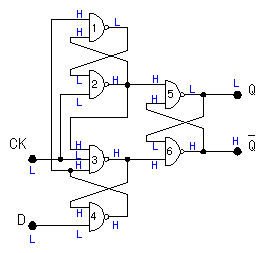
Because D is an L, the output of 4 is H.
The output of 4 becomes the input of 1 and the input of the upper-side of 1 becomes H.
Because CK is an L, the output of 2 is H, and as for the input of 1, both become H and the output of 1 becomes an L.
Because CK is an L, the outputs of 2 and 3 are H.
At this point, the output state of 5 and 6 is unsettled. Inside the IC, in case of the turning on, it seems that it initializes Q to the L condition and  to the H condition. to the H condition.
 When D is "H" and CK is "L" When D is "H" and CK is "L"
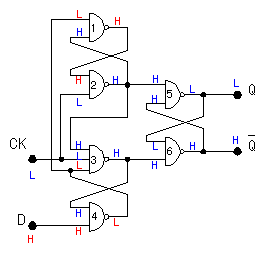
When D becomes H, as for the input of 4, both become H and the output of 4 becomes an L.
The output of 4 becomes the input of 1 and the output of 1 changes into H.
Because CK is an L, the outputs of 2 and 3 don't change and the Q and  don't change. don't change.
 When D is "H" and CK is "H" When D is "H" and CK is "H"
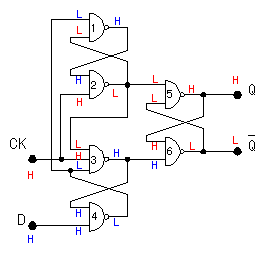
When CK becomes H when D is H, both input of 2 becomes H and the output of 2 becomes an L.
Because the output of 4 is an L, the output of 3 is as H.
When the output of 2 becomes an L, the output of 5 becomes H and the Q changes into the H condition from the L. Also, when the output of 5 becomes H, as for the input of 6, both become H, the output of 6 changes into the L and the output of  changes into the L condition from H. changes into the L condition from H.
 When D becomes "L" after the above change When D becomes "L" after the above change
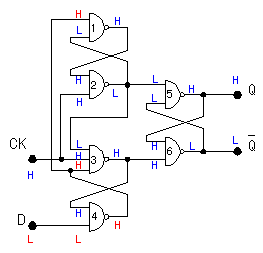
The lower-side of the input of 4 becomes an L and the output of 4 becomes H.
With it, because the lower-side of the input of 3 becomes H but the output of 2 is an L, the output of 3 is as H.
The H condition of the output of 4 becomes the input of 1 but because the output of 2 is an L, the output of 1 is as H.
That is, when CK doesn't become an L condition, the change of D doesn't have an influence on the change of Q.
When CK becomes an L, the output of 2 becomes H.
When D is an L, as for the input of 1, both become H and the output of 1 becomes an L. Even if the output of 2 becomes H, the outputs of 5 and 6 don't change.
 When D is "L" and CK is "H" When D is "L" and CK is "H"
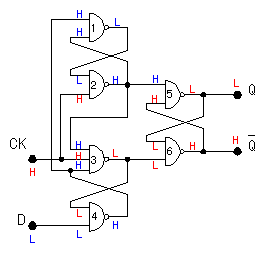
When CK becomes H, all inputs of 3 become H and the output of 3 becomes an L.
Because the output of 3 becomes an L, the output of 6 becomes H and  changes into the H condition from the L. Also, because the output of 6 becomes H, as for the input of 5, both become H, the output of 5 changes into the L and Q changes into the L condition from H. changes into the H condition from the L. Also, because the output of 6 becomes H, as for the input of 5, both become H, the output of 5 changes into the L and Q changes into the L condition from H.
 When D becomes "H" after the above change When D becomes "H" after the above change
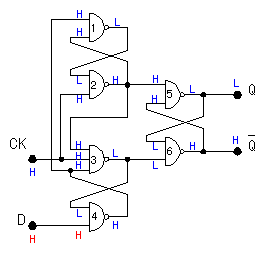
The lower-side of the input of 4 becomes H but because the output of 3 is an L, the output of 4 is as H.
That is, when CK doesn't become an L condition, the change of D doesn't have an influence on the change of Q.
When CK becomes an L, the output of 3 becomes H.
When D is H, as for the input of 4, both become H and the output of 4 becomes an L.
The output of 3 becomes H when CK becomes an L and doesn't change.
The L condition of the output of 4 becomes the input of 1 and the output of 1 becomes H.
When CK becomes an L, the input of the lower-side of 2 is an L and the output of 2 doesn't change as H.
Like above explanation, D-FF has the function to output the condition of input (D) in Q only at the time when CK changed into H from the L.
 |